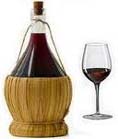Home Baked Bread
from Italian Traditional Food
Satisfying taste and smell of home baked
bread
Check out these great Italian ideas at Amazon for Italian food and kitchen ideas.
Nothing is more satisfying then the taste and warm smell of home baked bread,
yet how many people ever try making it? It's really very easy to bake your own bread,
and the taste is refreshingly different from the processed kind to which we have become so accustomed.
Successful home baked bread making lies in understanding your
ingredients and how to use them. Yeast and flour are both of great importance, so below are a few pointers about
them.
What is yeast?
Yeast is a living plant, needing warm moist conditions in which to grow. It is affected by
extremes of temperatures: excess cold will retard or check (but not kill) the growth, while strong heat will kill
it completely. This explains why bread dough can be mixed and stored before rising either in the refrigerator for a
short period, or in a deep freeze for a longer time.
After a long and slow rising process, the risen dough is baked in a hot oven to kill the yeast
which has done its work.
Sugar helps yeast to grow, so if creaming it with yeast take care not to overmix as it will
reduce its quantities; just stir in enough to bring it to a liquid.
Salt retards its growth if mixed with the yeast, so it is usually sifted with the flour or
dissolved in part of the liquid in the recipe.
Proportion of yeast to flour
The proportion of yeast to flour varies with the type of home baked
bread. Household breads use 1 oz yeast to 3 lb flour; light or milk breads, 1/2 oz yeast to 1 lb flour; rolls
and buns, 3/4 oz yeast to 1 lb flour.
The proportion of yeast to flour also affects the time allowed for rising. The smaller quantity
of yeast the longer the rising will take; the greater the quantity the shorter the time.
You can use either fresh compressed yeast or dried yeast. The former is not always easy to
obtain, but you can probably buy some from a baker who bakes on the premises. Full directions for using dried yeast
are always given on the tin or packet; it must soak in some of the liquid from the recipe for a given time before
being mixed with remaining liquid and flour.
Storing yeast
If you want to store fresh yeast, it will keep in a screw-top jar in the refrigerator for more
than a week. For longer periods store in the deep-freeze. If you haven't a refrigerator, press into a small jar or
pot until three-quarters full, then invert jar in a saucer of cold water. Yeast will then keep fresh and moist for
several days.
Flour
A special bread flour should be used for white home baked bread. It is called
"strong" flour and has a high gluten content. If you find this impossible to obtain, use plain flour. However, some
makes of plain flour are stronger than others, so do ask your grocer's advice.
There are also various grades of flour from fine white to coarse wholemeal for different types
of home baked bread and certain firms produce stone-ground flour which is ideal for
bread-making.
Page 2 of this Italian Traditional Food article can be found on the
next page.
Page 1 Next
>>

Copyright © 2009 -
. All Rights Reserved Worldwide. Italian Traditional Food
You may not reprint articles from this website
without the written permission of the site owner.
Disclaimer: Articles on this
Website are provided for information purposes only. Italiantraditionalfood.com does not accept any responsibility
or liability for the use or misuse of the article content on this site or reliance by any person on the site's
contents.
| 


 Digg
Digg Stumbleupon
Stumbleupon Google Bookmarks
Google Bookmarks Delicious
Delicious Twitter
Twitter Facebook
Facebook Yahoo My Web
Yahoo My Web Reddit
Reddit